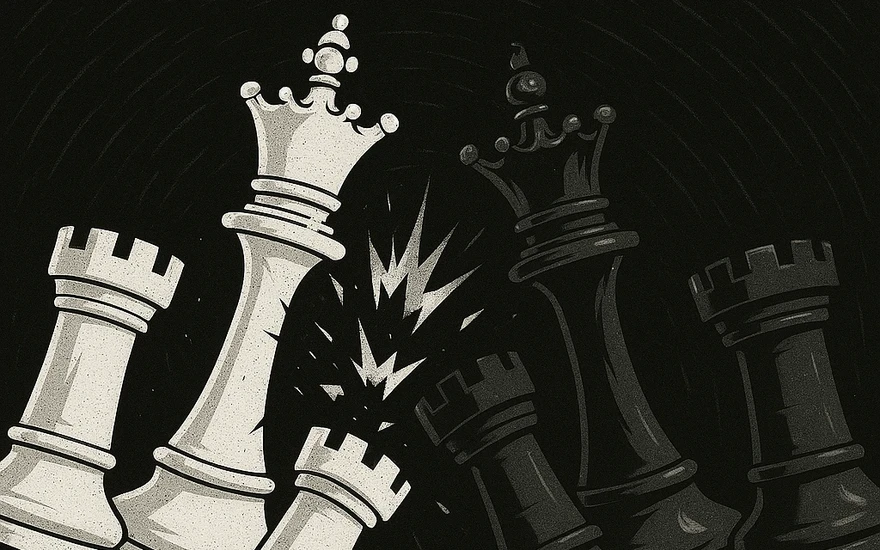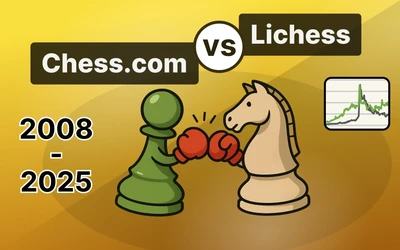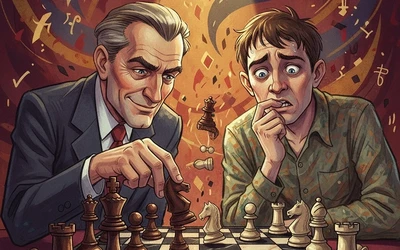
When Queens and Rooks Collide: Practical Battles to Learn From
Exploring practical middlegame and endgame moments when queens and rooks rule the board (14 positions that you can try to solve yourselves).Introduction
When a position simplifies to one where only the heavy pieces remain on the board, several key factors come into play:
- King Safety: The side with the safer king usually maintains greater control over the position.
- Initiative: The player who seizes the initiative — who attacks first — often gains a critical edge. When both kings are exposed, the first to launch an effective attack can even secure a decisive advantage.
- Passed Pawns: While passed pawns may seem less significant in such positions (as they can often be blockaded), their potential value depends greatly on their placement and the activity of the supporting pieces.
Quick Note: I have given links to the positions and the games itself for each example. To those who just want to enjoy can click on the second link in each example, as first link would be the critical position - without any moves
Dos & Don’ts
- Keep your king safe. Avoid back-rank weaknesses and ensure there’s always an escape square available.
- Maintain a solid structure. A stable pawn formation — especially around your king — provides long-term security and coordination for your pieces.
- Don’t expose your king. Opening files may activate your rooks, but it also gives your opponent access to those same lines; balance activity with safety.
Example 1: Goetz Andreas - Wegener Dirk (2009)
In this position both sides have back-rank issues. Lucky for black that it is their turn. How does black exploit white's weakness?
- Link to the critical postion [Hint: Just a one move tactic]
- Link to the game
Example 2: Alekhine Alexander - Colle Edgard (1925)
Is there anything special that white could do right now?
- Link to the critical position [Hint: The first move involves a sacrifice]
- Link to the game
Example 3: Gheorghiu Florin - Polugaevsky Lev (1973)
In this case, eventhough it is not the back-rank (which is the typical issue), both kings are extremly weak. Since it is white's turn to strike, they have the decisive blow. So how should white continue?
- Link to the critical position [Hint: Decoy]
- Link to the game
Example 4: Matlakov Maxim - Smirin Ilia (2017)
White's pieces are already organized & are ready for an attack on the Kingside. If black had even one minor piece on the kingside (or just one move), they could defend their king. However, It is white's turn now. If Matlakov has to get to Smirin's king, he first needs to do something about the pawns surrounding it (implies white needs to make a sacrifice to expose the king).
In the game, Matlakov failed to find the winning idea and Smirin survived. Now let's take a look at what happened and see what white missed...
Example 5: Kashlinskaya Alina - Bodnaruk Anastasia (2018)
In general, there are 2 major elements for an attack to be successful - Number of attackers & Momentum of the attack.
In this messy position, white (is to move) gets a decisive advantage if played correctly. However time is of the essence as white's king is very weak too. Hence needs to act immediately.
Congratulations to those who found the solution. Now lets observe the game and its details...
Example 6: Leko Peter - Khalifman Alexander (2000)
This is one of the most instructive games in this topic. This example is so famous that many books have this game/position included. White of course has safer options. But can white play for more? Without looking at the game, try to find the winning plan for white.
- Link to the critical position [Hint: White should try and lose the h7-pawn]
- Link to the game
Example 7: Alexander Alekhine - Max Euwe (1936)
I have taken this position from Mark Dvoretsky's & Artur Yusupov's Attack and Defence book. It is black to play.
Just like the previous example(6), black has safer options and is already materially up by a couple of pawns. But is there anything concrete for black to seal the deal?
Take a total of 10 minutes for this position if you want to solve it yourself.
- Link to the critical position
[Hint: There is a difference between starting with Qb1+ and d3 - use elimination to find which one is correct] - Link to the game
Example 8: Karpov Anatoly - Larsen Bent (1980)
Looks like black's king is safe. is it though? #diagram
Just observe how Karpov initiates the attack on black's king and combines it with the unprotected rook on g1.
Example 9: Eljanov Pavel - L'Ami Erwin (2014)
Here, both sides are going for an all-out-attack on their opponent's king. However it is white's turn to move now.
Should white defend the kingside temporarily before continuing the queenside attack or increase the firepower on the queenside?
- Link to the game
{Credits - Encyclopedia of Chess Combinations}
Example 10: Abramovic Bosko - Damljanovic Branko (1995)
White has a superior position. But is there anything tactical for white to take advantage of black's weak king on g7?
Example 11: Spraggett Kevin - Campbell Murray (1974)
In this postion, all of black's pieces have been positioned aimlessly on the queenside. This leaves their king vulnerable. White cannot take advantage of this fact if the queens come off the board. So how should white strike?
You are always welcomed to try finding the solution yourselves. But to those who want to enjoy, here's the game
Example 12: Ftacnik Lubomir - Farago Ivan (1987)
Despite the fact that the king is still in the center, white's pieces are very active. Do you think that the lonely black's queen could defend her king?
Let's take at look at how Ftacnik launches an attack on the kingside.
Example 13: Moiseenko Alexander - Macieja Bartlomiej (2009)
In the following position, Moiseenko finds a stunner that leaves Macieja with no choice but to move his king.
It might look like black could hold, but there are many strategic elements in this position that favours white.
Now let's see what happened in the game.
Example 14: Fedorov Alexei - Karthik Rajaa (2023)
I have encountered several situations myself, where the heavy pieces dominate the board. This case is an exception to the above examples. I would like the readers to also take a look at the text & analysis which is inscribed in the game PGN (together with the notations) - to get a better understanding.
Inference
The main takeaways from this topic are;
- Keep your king safe
- Ensure that you are the first one to strike
- When attacking make sure that you include all the pieces
- Your attack must be swift to avoid counterplay
I hope this was useful.
Thank you for reading! :)
Do comment on what topic you would like me to write next...Cheers!
You may also like
 FM CheckRaiseMate
FM CheckRaiseMateI Don't Like Chess Tournaments
It doesn't have to be this way! IM adapodadeiii
IM adapodadeiiiMy personal favourite games of the Grand Swiss 2025
Among the 638 games played in the FIDE Grand Swiss 2025, I have identified 20 that I consider especi… ChessMonitor_Stats
ChessMonitor_StatsWhere do Grandmasters play Chess? - Lichess vs. Chess.com
This is the first large-scale analysis of Grandmaster activity across Chess.com and Lichess from 200… FM MathiCasa
FM MathiCasaChess Football: A Fun and Creative Variant
Where chess pieces become "players" and the traditional chessboard turns into a soccer field FM MattyDPerrine
FM MattyDPerrine